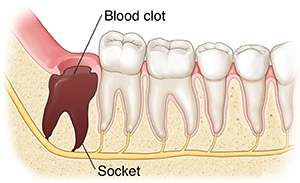Dry Socket

After a tooth is removed (extracted), a blood clot forms in the space where the tooth was. This clot protects the underlying bone until the gum has healed. Dry socket occurs when the blood clot dissolves or falls out too soon, exposing the bone and nerves. This may cause severe pain, which can extend to the jaw or other parts of the face and head. Symptoms usually occur 1 to 3 days after surgery. Dry socket is more common after wisdom tooth extraction or if the extraction was difficult. Infection also makes dry socket more likely. Smoking or taking birth control pills can also increase the risk.
Home care
Medicines
Your healthcare provider may prescribe medicine for pain or infection. Follow the healthcare provider’s directions when using these medicines. If you are given an antibiotic medicine for infection, take it exactly as directed. Don't stop taking it until you are told to even if you are feeling better.
General care
-
If the socket was packed with gauze, follow the healthcare provider’s directions to care for it. Follow up with your oral surgeon or dentist to have the gauze changed.
-
Rinse your mouth with saltwater or a prescribed mouthwash a few times a day as directed by your provider. This flushes food particles from the socket. You may be given a syringe to help flush the socket. If this is the case, follow the healthcare provider’s directions closely.
-
Place a cold pack wrapped in a thin towel on your jaw over the sore area for 10 minutes at a time to help reduce pain and swelling.
-
Don’t drink from a straw. The sucking action can pull out the clot, making the pain worse.
-
Don’t eat foods that are hard and may poke the socket. Don’t have hot or cold food and drinks until the socket heals.
-
Don't smoke. Ask your healthcare provider for resources to help you quit.
Follow-up care
Follow up as directed with your oral surgeon or dentist. Often, your surgeon or dentist will pack the socket until healing is complete. Your pain may improve with the treatment given, but only an oral surgeon or dentist can fully evaluate and treat your dry socket.
-
If a culture was done, you will be told if the treatment needs to be changed. You can call as directed for the results.
-
If X-rays were done, they will be reviewed. You will be told the results and if they affect your treatment.
Call 911
Call 911 if any of the following occur:
-
Trouble breathing or swallowing
-
Wheezing
-
Hoarse voice or trouble speaking
-
Confusion
-
Extreme drowsiness or trouble waking up
-
Fainting or loss of consciousness
-
Rapid heart rate
When to get medical advice
Call your healthcare provider right away if any of the following occur:
-
Increased swelling and redness of the face
-
Pain that gets worse or spreads to the neck or ear
-
Fever of 100.4°F (38°C) or higher, or as directed by your healthcare provider
-
Unusual drowsiness, headache or stiff neck, weakness
-
Pus draining from the tooth socket
-
Bleeding that is severe or won’t stop with pressure on the area.
-
Bad smell and taste in your mouth
Online Medical Reviewer:
Jessica Gotwals RN BSN MPH
Online Medical Reviewer:
Michael Kapner MD
Online Medical Reviewer:
Rita Sather RN
Date Last Reviewed:
12/1/2022
© 2000-2024 The StayWell Company, LLC. All rights reserved. This information is not intended as a substitute for professional medical care. Always follow your healthcare professional's instructions.